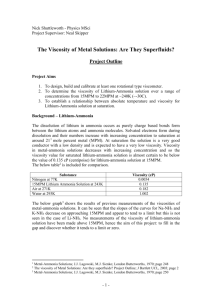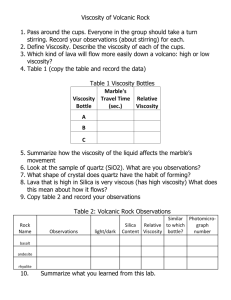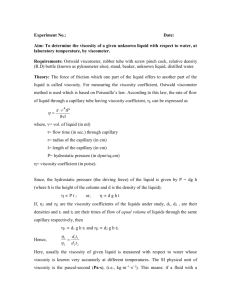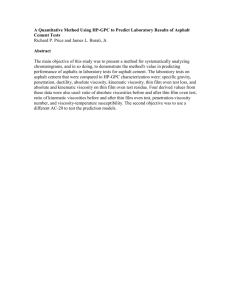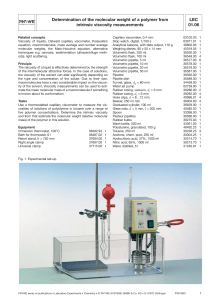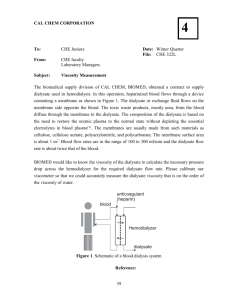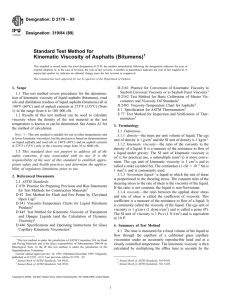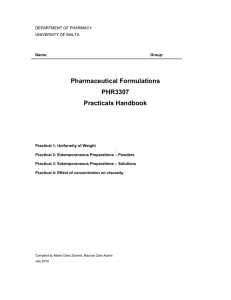Viscosity & Concentration Lab: U-Tube Viscometer Experiment
advertisement
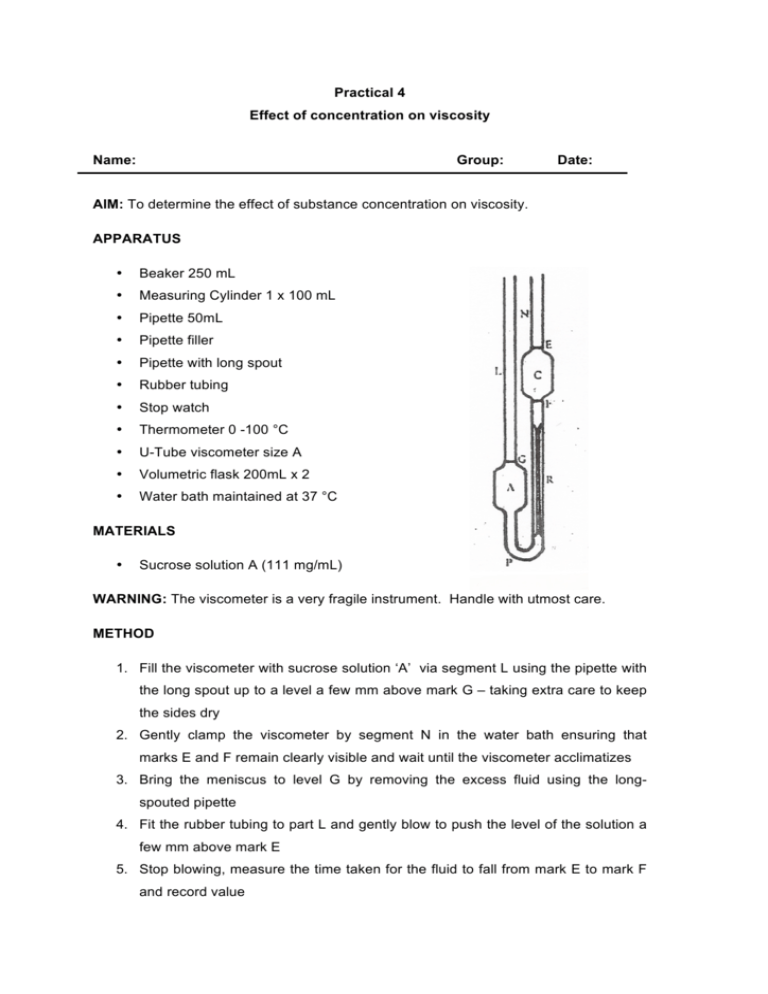
Practical 4 Effect of concentration on viscosity Name: Group: Date: AIM: To determine the effect of substance concentration on viscosity. APPARATUS • Beaker 250 mL • Measuring Cylinder 1 x 100 mL • Pipette 50mL • Pipette filler • Pipette with long spout • Rubber tubing • Stop watch • Thermometer 0 -100 °C • U-Tube viscometer size A • Volumetric flask 200mL x 2 • Water bath maintained at 37 °C MATERIALS • Sucrose solution A (111 mg/mL) WARNING: The viscometer is a very fragile instrument. Handle with utmost care. METHOD 1. Fill the viscometer with sucrose solution ‘A’ via segment L using the pipette with the long spout up to a level a few mm above mark G – taking extra care to keep the sides dry 2. Gently clamp the viscometer by segment N in the water bath ensuring that marks E and F remain clearly visible and wait until the viscometer acclimatizes 3. Bring the meniscus to level G by removing the excess fluid using the longspouted pipette 4. Fit the rubber tubing to part L and gently blow to push the level of the solution a few mm above mark E 5. Stop blowing, measure the time taken for the fluid to fall from mark E to mark F and record value PHR3307 6. Repeat steps 4 and 5 one more time and document second value 7. Transfer 100 mL of solution ’A’ to a 200 mL volumetric flask and make up with water to 200 mL while mixing 8. Empty the viscometer and rinse with a few aliquots of the solution prepared in step 7 9. Repeat steps 1 to 6 using the solution prepared in step 7 10. Transfer 100 mL of the solution prepared in step 7 to a 200 mL volumetric flask and make up to the mark with water while mixing 11. Empty the viscometer and rinse with a few aliquots of the solution prepared in step 10 12. Repeat steps 1 to 6 using the solution prepared in step 10 13. Transfer 100 mL of the solution prepared in step 10 to a 200 mL volumetric flask and make up to the mark with water while mixing 14. Empty the viscometer and rinse with a few aliquots of the solution prepared in step 13 15. Repeat steps 1 to 6 using the solution prepared in step 13 16. Empty the viscometer and rinse with water 17. Repeat steps 1 to 6 using water RESULTS Table 1: Tabulate time taken for fluid to fall from mark E to F Time taken for fluid to fall from mark E to F (s) Solution T1(s) T2(s) 1 2 3 4 5 2 MCZ/ASI ‘11 PHR3307 CALCULATIONS 1. Determine the kinematic viscosity ‘v’ for each solution using the following formula: v=kt v = kinematic viscosity in area covered per second (mm2s-1) Where: k = viscometer constant = 0.003mm2s-2 t = time in seconds (s) Table 2: Average kinematic viscosity Kinematic Viscosity v1 (mm2s-1) Solution v2 (mm2s-1) vav (mm2s-1) 1 2 3 4 5 2. Calculate the sugar concentration (mg/mL) for each solution Table 3: Concentrations of each solution Solution Concentration (mg/mL) 1 2 3 4 5 3 MCZ/ASI ‘11 PHR3307 3. Using the following formula check if a plot of average kinematic viscosity versus concentration would fit a straight line R= Σ(x – x1) (y – y1) √Σ(x – x1)2(y – y1) 2 Where: x1 = mean value for x (independent variable i.e. concentration) y1 = mean value for y (dependent variable i.e. kinematic viscosity) Table 4: Tabulate values for the calculation of regression analysis x (x – x1) (x – x1)2 y (y – y1) (y – y1) 2 (x – x1) (y – y1) (x – x1)2(y – y1)2 1 2 3 4 5 Σ Σ R = ______________ 4. What can you conclude from this? ___________________________________________________________________ ___________________________________________________________________ ___________________________________________________________________ 4 MCZ/ASI ‘11 PHR3307 5. Plot a graph of kinematic viscosity (y) against sugar concentration (x) Table 5: Values for graph: kinematic viscosity vs. sugar conc. Sugar conc. (mg/mL) Kinematic viscosity (mm2s-1) 5 MCZ/ASI ‘11 PHR3307 QUESTIONS 1. List three (3) important precautions that have to be taken when conducting this test ______________________________________________________________________ ______________________________________________________________________ ______________________________________________________________________ 2. List one (1) source of error ______________________________________________________________________ 3. Discuss the outcome of this experiment – what can we state from our findings? ______________________________________________________________________ ______________________________________________________________________ ______________________________________________________________________ ______________________________________________________________________ 4. What do you understand by the term ‘viscosity’? ______________________________________________________________________ ______________________________________________________________________ ______________________________________________________________________ 5. Define kinematic viscosity ______________________________________________________________________ ______________________________________________________________________ ______________________________________________________________________ 6. List two (2) examples of viscosity modifiers commonly used in modifying suspension viscosity ______________________________________________________________________ ______________________________________________________________________ ______________________________________________________________________ ______________________________________________________________________ ______________________________________________________________________ 6 MCZ/ASI ‘11 PHR3307 7. Give one (1) example where the viscosity of a formulation is important in the administration of a drug ______________________________________________________________________ ______________________________________________________________________ ______________________________________________________________________ 8. Why is it important to take two ‘time readings’ per concentration tested, and how can we ensure suitability of values? ______________________________________________________________________ ______________________________________________________________________ ______________________________________________________________________ ______________________________________________________________________ 9. List three (3) parameters that are kept constant in this experiment ______________________________________________________________________ ______________________________________________________________________ ______________________________________________________________________ 10. Why are viscosity-increasing agents important in ophthalmic preparations? Give two (2) examples of such agents ______________________________________________________________________ ______________________________________________________________________ ______________________________________________________________________ ______________________________________________________________________ ______________________________________________________________________ 11. What is the minimum number of data points one should take when testing a method for linearity? ______________________________________________________________________ ______________________________________________________________________ ______________________________________________________________________ ______________________________________________________________________ ______________________________________________________________________ 7 MCZ/ASI ‘11 PHR3307 12. How would viscosity impact on the bioavailability of drugs? Substantiate your answer by giving a suitable example ______________________________________________________________________ ______________________________________________________________________ ______________________________________________________________________ ______________________________________________________________________ ______________________________________________________________________ ______________________________________________________________________ ______________________________________________________________________ 13. Should the temperature be kept constant when measuring viscosity of fluids? Explain why ______________________________________________________________________ ______________________________________________________________________ ______________________________________________________________________ 14. What do you understand by a Non-Newtonian liquid? Give a typical household example of such a liquid ______________________________________________________________________ ______________________________________________________________________ ______________________________________________________________________ ______________________________________________________________________ ______________________________________________________________________ 15. Would you expect the capillary (Ostwald) viscometer to be a suitable piece of equipment in determining the viscosity of non-newtonian liquids? ______________________________________________________________________ ______________________________________________________________________ ______________________________________________________________________ Demonstrator Name Signature 8 MCZ/ASI ‘11 PHR3307 9 MCZ/ASI ‘11



